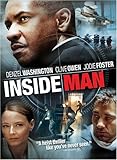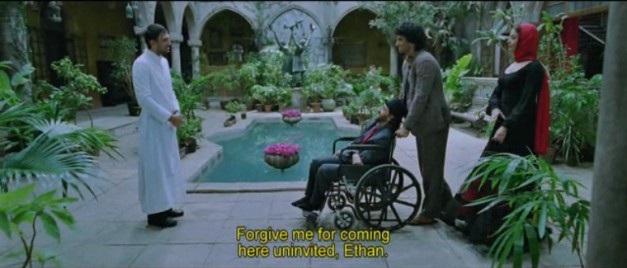Watch the trailer of the biopic of the late quadriplegic cartoonist John Callahan, who was paralyzed in a car accident at age 21 and turned to drawing as a form of therapy.
Code of the Freaks
Fans of Salome Chasnoff’s previously linked Hollywood Images of Disability (since disappeared) can breathe a little easier now; it hasn’t gone away for good, it’s just being reworked into a full length documentary titled Code of the Freaks.
Musical Chairs
Musical Chairs opens to scenes of an urbanized, working-class NYC neighborhood purportedly in the Bronx, but with a lot of scenes filmed in Brooklyn. Puerto Rican flags flutter in the air, old Hispanic men play dominoes at outdoor card tables, and a middle-aged Puerto Ricans woman with dyed dark hair, dark red lipstick, and a low-cut dress walks into a botanica for candles and a love potion. The occult aids to romance are not for herself, she is more or less happily married, but for her young adult son Armando, who is still single. At the botanica, she also picks up Rosa, a girl of similar background and long raven hair, whom she deems to be a suitable match for Armando, and spends a lot of time in the movie trying to throw her in his way. All budding drama of a conventional sort and within a milieu of the Hispanic culture and striving socioeconomic class within which they live (Rosa is going to college for accounting, while Armando works in a Times Square area Manhattan dance studio by day, and his family’s outer-borough restaurant by night).
While his mother initially seems to have a clear agenda as to whom he should settle down with and what future path he should take, Armando has his own ideas about his prospective romantic partner. He has been admiring blonde German-English Mia, an advanced dance student and social partner of his boss at the dance studio.
“Mia and Armando’s worlds are as far apart as you can imagine: she’s from the Upper East Side hailing from a well-to-do family; Armando works at his family’s restaurant in the Puerto Rican section of Bushwick, Brooklyn,” says producer/actor Joey Dedio. However, it takes some time to get into a circumstance where he is alone with her and they can do some romantic dancing. It is shortly after that encounter when Mia, reminded that she had forgotten her scarf, tries to cross the street to get back to the studio and is mowed down by an errant taxicab. It is this tragic accident which provided the entree to the world of the disabled for two able-bodied young people who were seemingly unlikely to have encountered disability issues otherwise (neither one is seen to have friends or relatives in wheelchairs before the fateful incident). This is also how they meet other patients in the hospital also in wheelchairs, who are interesting and compelling, if not realistic characters. A goth girl, a right-winger, and a transexual are among them.
Armando, undoubtably feeling guilty for his role in the accident which led to the spinal cord injury which put Mia in a wheelchair, plays the “good boyfriend” and constantly visits Mia in the hospital, brings her flowers, and suggests that they go to in-hospital actvities together. (The other suitor has conveniently disappeared. It is never said outright, but perhaps he is no longer interested now that Mia is no longer able-bodied. Nevertheless, Armando is.) Mia, still under the influence of situational depression, nixes every activity Armando suggests, including the on-line video he shows her of wheelchair dancing. In order to overcome her reluctance and provide a situation in which they could engage in wheelchair dancing, Armando attempts to organize a wheelchair dancing class at the hospital. He is met by bureaucratic opposition from a white, upper-class hospital administrator, who cited budget concerns and insurance liability, even though Armando said he would volunteer to teach the class for free, and the hospital already plays host to wheelchair basketball in their gymnasium. (Besides wheelchair basketball, there also seems to be a rec room with a public internet-connected computer and an aquatherapy room with an enviable pool)
Downcast, he pours out his troubles to the plump black working-class nurse on duty, who believes in his effort sufficiently to collude with him in getting around the bureaucratic obstacle, and as keeper of a stuffed keychain, enables him to utilize the gym after the wheelchair basketball team have finished. When this insubordination is discovered, as it inevitably would be, she enables the wheelchair dance class to continue by blackmailing Mr. Grinker with the fact that her iPhone contains video footage of him flirting with a blonde at the office Christmas party which would cause even more drama if it were revealed to his wife.
Though his wheelchair dance class initially gets off to a slow start, new life and catchy music are injected into it by one of the patients, a black transsexual who later enlists a group of his/her gay/trans friends to make costumes for the dancers, who later, in the name of drama, end up entering a wheelchair ballroom dancing competition.
There are a couple of instances in the movie pointing out some other practical issues facing people with physical disabilities as well as societal stigma and myth-making. When Armando’s mother first becomes aware that he is seeing Mia, she is inclined to discourage the budding romance not only because she favors Rosa, but because she may well believe some misconceptions about women in wheelchairs. She articulates a few, along the lines of “she can’t make Armando happy”, and (what if) “she can’t have children”.
After having done some Santeria to try to bring Armando and Rosa closer, Armando’s mother eventually changes course and tells Mia the reason for the change of heart is, “I’ve seen the way he looks at you”.
After the accident, Mia’s parents try to get her to move back to the family home, on the grounds they could “have it totally renovated” for wheelchair access (presumably they have unlimited finances). But, cherishing her independence, she wants to return to life in her own apartment. She and Armando return there for a visit: while Armando is willing and able to carry her up multiple flights of stairs to get there, Mia realizes that she cannot live there again: “the cabinets are all too high”, and a number of other things are wheelchair-unfriendly. The goth girl gets stares and questions about her wheelchair from curious children. Wheelchair ballroom dancing, as it turns out, requires an able-bodied partner for each person in a wheelchair, and as one of the participants in Armando’s clandestine class in the hospital said, referring to the isolated and institutionalized character of their lives at that time” where are we going to get one of those?” Armando’s traditional extended Latino family comes to the rescue, and helps bring about some comic relief, as well as a happy ending for all but perhaps the goth girl with the vanity wheelchair.
Guzaarish
 Guzaarish (Hindi for “Request”) is the Bollywood remake of “Whose Life is it Anyway?”, and yet another example of the “right to die” disability movie trope.
Guzaarish (Hindi for “Request”) is the Bollywood remake of “Whose Life is it Anyway?”, and yet another example of the “right to die” disability movie trope.
The story centers around Ethan Mascarenhas, once a famous magician, who became a quadriplegic when his best friend betrayed him during a dangerous trick. Ethan has seemingly done well as a quad; he wrote a popular book and appears to have toured to promote it, he’s a Radio Jockey of a popular program called Radio Zindagi, has a romantic if gloomy mansion on a hill, two live-in servants and a nurse, and a sip-and-puff motorized wheelchair. From his home-based studio he exhorts his radio listeners to find beauty in their lives and boasts about his program being the most joyful on the air.
That’s why it’s so surprising when, on his 14th anniversary of becoming a quadriplegic, Ethan suddenly announces that he wants to end it all, and instructs his best friend (a lady lawyer) to file a petition with India’s courts for euthanasia. (Or, as he calls it on his radio program, “Ethanasia”.)
He also suddenly begins snapping at his caregivers and even makes a sexually harassing remark or two to Sophia, his nurse. Disabled viewers probably start wondering if Ethan has some underlying mental health issues at this point.
While it is impossible to deny that many people with disabilities–particularly the newly disabled–are indeed suicidal, “right to die” movies such as Guzaarish are problematic because movies are the primary vehicle for the able-bodied to learn about the lives of the disabled. Suicidal tendencies among the disabled are seen as a perfectly rational, and even noble, response to their condition; a movie such as this only reinforces such perceptions. Depression is thus left untreated and available services unapplied for. Studies show that once disabled people are offered adequate services, pain relief, and adaptive equipment to maximize their independence, they become much less likely to be suicidal.
And indeed Guzaarish bears this out; during the court hearing, it is revealed that Ethan’s mansion is mortgaged to the hilt, and he only has enough savings to cover Sophia’s salary for two more months. Further cracks in Ethan’s cheerful facade begin to appear upon examination. He may have a proper motorized wheelchair, but he only uses it in the beginning of the film. The rest of the time, he’s hauled about slumped in an ill-fitting manual wheelchair. Perhaps his town isn’t particularly wheelchair accessible, nor does he seem to have access to an adapted van or paratransit services. But that doesn’t explain why he hasn’t installed himself on the first floor of his mansion instead of the second, nor added ramps about the extensive grounds. Perhaps he wouldn’t be so depressed if he made an effort to get out more than once in a decade?
Any quadriplegic viewing the above image is now wondering why Ethan bothered to go through the court system, when the means of offing himself are already at his disposal. Clearly Ethan is crying for help, and those cries are amplified when he puts Ethanasia up for a vote on his radio program after the courts deny his initial petition. Most callers vote no; a handful, including Ethan’s former lover, crushingly vote yes. If Ethan wasn’t depressed before, he surely is now.
A judge decides to hear Ethan’s case, and even moves the courtroom to the foyer of Ethan’s home to accommodate his trouble getting around. Ethan uses showmanship to lock the prosecutor into a trunk, and when he begs for release before a minute is up, Ethan tries to make the point that the prosecutor couldn’t tolerate being confined for even a minute. The judge still denies his request, but Ethan has one more ace up his sleeve: Sophia.
Sophia and Ethan declare their love for each other, and she agrees to marry and then kill him, damn the consequences. They have the most uncomfortable wedding imaginable, with the groom dressed up on his deathbed insulting his guests one by one. Ethan’s doctor friend nearly leaves, but is convinced to stay. All pile on the bed to wish him farewell. If there’s one thing to be grateful for, it’s that Guzaarish narrowly avoids the disability movie cliche of the disabled character dying onscreen.
The Ex
 The Ex is a movie about marital mishegoss with a twist. While there are plenty of movies about married couples where one or the other’s “exes” are re-encountered, usually to challenge marital fidelity, I think this is the first I have seen where the ex in question appears to have an obvious physical disability; he is in a wheelchair, said to be “paralyzed from the waist down”. Having worked his way up in the field of advertising, Chip has nevertheless (no wheelchair ramp to the ad agency is shown) accomplished more career success than Sofia’s husband Tom, who starts out as a chef, but in order to make the money to enable his wife to stay home when she has a baby, he moves to Ohio and takes a job with his father-in-law at the advertising company where Chip, the ex, is a co-worker.
The Ex is a movie about marital mishegoss with a twist. While there are plenty of movies about married couples where one or the other’s “exes” are re-encountered, usually to challenge marital fidelity, I think this is the first I have seen where the ex in question appears to have an obvious physical disability; he is in a wheelchair, said to be “paralyzed from the waist down”. Having worked his way up in the field of advertising, Chip has nevertheless (no wheelchair ramp to the ad agency is shown) accomplished more career success than Sofia’s husband Tom, who starts out as a chef, but in order to make the money to enable his wife to stay home when she has a baby, he moves to Ohio and takes a job with his father-in-law at the advertising company where Chip, the ex, is a co-worker.
Chip still wants to have a relationship with Sofia, and as a master manipulator of people and situations, he makes Tom look bad on his job, gets Sofia’s father fired, and appears to be making progress getting Sofia nearer to getting into bed with him. It is made clear elsewhere in the movie that Chip gets sympathy (and sex) from women. However, Tom, convinced that Chip is faking his physical disability, tangles with him on several occasions as their relationship gets increasingly hostile.
Strangely, perhaps because it is easier to portray on screen than the subtleties of office politics, Tom is more overtly concerned with the idea that Chip is faking his physical disability than with proving his attempts to effect Tom’s career sabotage or the fact that Chip is making time with his wife, though the latter is something which is sufficiently motivating for Tom to threaten Chip. On one occasion, Tom tries to expose Chip as a faker by getting him out of his wheelchair and pushing him down the stairs, convinced that the instinct for self-preservation will kick in and Chip with move his legs and right himself to avoid the fall, but Chip does not do this and Tom ends up looking even worse in front of others. Chip has Tom in a bind, because Tom feels guilty about having negative feelings about a man who can’t walk, and society condemns Tom for hostility towards a man in a wheelchair, no matter how deserving he may be. The one bright spot is that Chip has applied for a job in Spain, and, if he gets it, he will be leaving, after all. (Chip’s less obvious mental disability is that he is a sociopath.)
Everything seems to be going Chip’s way, but in order to establish to the audience that Chip is, indeed, a wheelchair villain, towards the end of the movie, he gives a movie villains’ monologue of the sort usually declaimed by James Bond movie villains and Dr. Evil. Chip, Tom, and Sofia are at a restaurant sitting around a table when Chip reveals that he has defeated Tom “in every possible way” including in the eyes of his Sofia, whom he invites on a plane to Spain.
But at the last minute, in order to effect a “happy ending” for the married couple and to imply the intervention of a Higher Power dealing out cosmic justice, the tables are turned on Chip: Sofia refuses Chip’s offer, and declares to Tom, “You couldn’t lose me even if you tried. And you’ve been trying really hard lately.” Chip, in the midst of gloating, reveals he _has_ been faking his disability “have you tried to get a parking spot at the mall during Christmas shopping season?”, stands up, and leaves the restaurant on foot, doing a victory dance while lifting his wheelchair over his head, looking into the window of the restaurant, but not into oncoming traffic, where a bus promptly runs him over. He gets paralyzed from the waist down for real this time, and (this surely has to be Divine Justice for his sexual misconduct) it is discovered that he has testicular cancer.
Tom and Sofia manage to get a job and an apartment in NYC, and settle down with baby Oliver, having gotten their nuclear family off to an enviably secure start.
Inside Man
 You might think Inside Man‘s “Mobile Command Officer Rourke” is just another non-disabled actor plopped into a wheelchair for a bit part as the token cripple–there’s no way a uniformed policeman in a wheelchair could easily get inside a mobile command unit with narrow doorways and stairs–but Daryl “Chill” Mitchell is the real deal.
You might think Inside Man‘s “Mobile Command Officer Rourke” is just another non-disabled actor plopped into a wheelchair for a bit part as the token cripple–there’s no way a uniformed policeman in a wheelchair could easily get inside a mobile command unit with narrow doorways and stairs–but Daryl “Chill” Mitchell is the real deal.
Born a biped in the Bronx, New York City, Mitchell enjoyed success as both a rapper in the ’90s and later as an actor in House Party and its sequel, Sgt. Bilko, Galaxy Quest, 10 Things I Hate About You, and the TV sitcoms The John Larroquette Show and Veronica’s Closet. He was paralyzed from the waist down by a motorcycle accident in 2001. Fortunately, Mitchell already had a disabled friend to show him the ropes, and support from friends including Denzel Washington and Chris Tucker allowed him to continue his acting career.
He has since appeared on TV shows Ed, Law and Order, Brothers, Desperate Housewives, and Wizards of Waverly Place, started the Daryl Mitchell Foundation, received the NAACP Image Award, and serves as a spokesperson for the Christopher Reeve Foundation.
My Own Love Song
 My Own Love Song is a story about life after a car accident for a women who survived paraplegia and a stay in the psych ward. The movie opens with Jane Wyatt, a former singer, being chatted up by a man in a bar who seems to be into her, but realizes that he “has to go somewhere” after he spots her wheelchair.
My Own Love Song is a story about life after a car accident for a women who survived paraplegia and a stay in the psych ward. The movie opens with Jane Wyatt, a former singer, being chatted up by a man in a bar who seems to be into her, but realizes that he “has to go somewhere” after he spots her wheelchair.
Jane Wyatt has a son, but her child had been taken away to foster care by the State after the accident. While disability, sudden or not, should not mean that your children are taken away, it may be that the jurisdiction where the story is set has a law similar to the one in NY that states that when parents get a diagnosis of mental illness and/or become inpatients in a psychiatric hospital, their children must be removed from parental custody. There is lobbying in NY to get this law changed, though there are some merits to this approach.
It is because Jane feels that her house, her finances, and her capacity to act as an effective, loving parent after having been absent from her son’s life for so long are inadequate, that she hides a letter from her son, inviting her to his Communion party. The concealed letter is found after some snooping around the house on the part of Joey, her “buddy”, a black man with a stammer and a seeming anxiety problem who serves as her informal personal care attendant and “shadow”, and describes himself during the course of the picture as “an ex-fireman” and “her bodyguard”.
The problem is that he is also a “specialist who can talk to ghosts”, sees angels in the sky, and gets into physical confrontations with people who mock this belief in the supernatural. It is implied that Joey is a schizophrenic. There are a couple of well-designed scenes which depict his perception and the angels he presumably sees in a subtle fashion. (Just as magically and mystically, the parking lot of the motel where they sit and look at the moon has a petite wooden wheelchair ramp leading from the curb to the blacktop.)
While it is clear that Jane, who met Joey in the psych ward, does not share his beliefs about the supernatural, and is put in untoward situations with the neighbors and the authorities when he decompensates or escapes from the psychiatric hospital, she nevertheless considers that The System gave him a raw deal, lying to cover for him when the police and mental health authorities come to her door, looking for him and reminding her of the penalty for harboring a fugitive. (Situations like these are enough to make a schizophrenic paranoid.)
The two decide to leave town until the situation cools off, and set off in a car that, soon after, catches fire. Any self-respecting paraplegic would have thrown themselves out of the smoking car, but Jane waits for Joey to retrieve her and her wheelchair. Indeed, Jane often is shown with someone pushing her (which actually annoys many genuine paraplegics to the point that they remove the push handles from their wheelchairs). She largely depends on Joey day-to-day, even though there are times when he has the potential to be a danger to himself and others. She has a manual chair, a regular car without hand controls which someone else (usually Joey) drives.
Life has some unusual hazards for female paraplegics. While Jane seems to have the ability to go some places without Joey–she attends physical therapy sessions outside the home, how she gets there is not shown–she is on several occasions confronted with situations that range from vaguely creepy to genuinely dangerous, like the man she meets on her journey who offers to give her a shower, or a bubble bath, and asks if she can “feel anything”. He explains by saying “for a long time, I couldn’t feel anything in here (indicating his heart). I can walk, but I think I’m crippled, too”. He proves it when he takes off in her new (to her) car after nothing happens between them.
Jane, Joey, and Billie (a non-disabled woman they pick up who becomes something of a love interest for Joey despite her erstwhile married status) must continue their journey on inaccessible buses and trains. On one train platform, Billie decides to return to her plain life, without the nuts.
The movie comes to a presumably happy ending after Jane resumes her singing career (she somehow gets on stage at a honky-tonk in spite of there being no wheelchair ramp to the platform being in evidence), reconnects with her son and performs with Joey on guitar at the Communion party, and embarks on a relationship with Joey; schizophrenia, angel sightings, and all.
Warning: deaf and hard-of-hearing folks should not rent this movie from Netflix or buy it. Legende Films deliberately removed the captions from the rental DVDs in order to force people who need them to buy the DVD, and Netflix did not see fit to declare such disks defective. For this reason, My Own Love Song goes in the Disability Movie Hall of Shame.
The Haunted Airman
 Based on the novel The Haunting of Toby Jugg, The Haunted Airman is set in a mansion in rural Wales during WWII. The main character is a former RAF pilot who has been shot down and has ended up in a wheelchair due to his injuries. However, his injuries are not soley physical, it is implied that he, like at least one other similar man in the tumbledown manor house being used as a makeshift hospital, is also suffering from PTSD, then known as “shell shock” or “battle fatigue”.
Based on the novel The Haunting of Toby Jugg, The Haunted Airman is set in a mansion in rural Wales during WWII. The main character is a former RAF pilot who has been shot down and has ended up in a wheelchair due to his injuries. However, his injuries are not soley physical, it is implied that he, like at least one other similar man in the tumbledown manor house being used as a makeshift hospital, is also suffering from PTSD, then known as “shell shock” or “battle fatigue”.
Having not lived through WWII and possessing only a limited exposure to England, I cannot speak on whether the portrayal of the facilities and technology at this particular hospital is a realistic depiction of institutions of this kind. But they are true to life in calling nurses “sister” and having them wear nun-like headdresses. And they are pretty spot-on as concerning some things that patients often experience in any sort of hospital. One of the early scenes in the movie shows the former pilot lying on a litter left in front of the hospital for what seems an indeterminate amount of time while people hurry by.
Yes, in real life, patients really do get left lying around. When he experiences incontinence and the nurse changes the bedsheets and tells him it’s nothing to worry about, but something that tends to happen “at the beginning”, that’s quite accurate too. (Real nurses are quite blase about things like this and talk about bodily functions openly, including the ones that embarrass most people.)
However, he’s got bigger problems than paraplegia or PTSD. It is hinted early in the picture that he is having or has the potential to have, an improper relationship with his aunt (aunt by marriage, at least), a thing that many people would find quite shocking, but it doesn’t seem to bother him, and the aunt seems amenable to it in the middle of the picture, holding hands with him and kissing him romantically during a visit with him. On later visits, she grows more distant, presumably on the doctor’s advice. By the end of the picture, she had repudiated that sort of relationship with him. When he makes sexual overtures to her, she is unwilling… and then his Oedipus gets even more complex.
Where the film starts to diverge from reality, however, is in depicting some of the frightening, hallucinatory experiences that he has.
It is true that the building in which he is in is an older building with a lot of dark wood and stone and shade trees is perhaps a theatre in which an overactive imagination can romp. Spiders are also prominently featured; perhaps they assume increasing importance to him because he is less able to avoid them with his present mobility-impairment and wheelchair use. The wheelchair they have him in is not the kind that he can push himself, and on one occasion when the nurse pushes it, she wheels him right into a big spiderweb. Another reason that spiders assume additional importance is because he has a situation of enforced idleness, and it is perhaps fair to say that he notices them more than when he was working.
Or maybe, there are just simply a whole lot of big, ugly spiders around.
In spite of the large and prominently featured spiders, insects in numbers make an appearance, too. At one point he sees a number of beetles walking by while he is in bed and he falls out of bed trying to chase them away. On another occasion when something like this happens, he drags himself away from his hospital room and into a bathroom, where he retreats to a bathtub, which (the viewer sees) has spiders in the drain. The doctor who is treating him (it is hinted that this doctor is acting as a therapist of sorts whether or not he is actually recognized as a psychiatrist) characterizes it as an attempt to retreat to the womb and the amniotic fluid in spite of the fact that the bathtub in fact had no water.
It can be hard to follow this picture because it is sometimes unclear as to whether some of the things they show are hallucinations on the part of the airman, or real but unpleasant things (like the spiders) just setting an uncomfortable and “creepy” atmosphere. I do not know whether this is deliberate on the part of the filmmakers or accidental as a limitation of the technology and/or the storyline. But it is a reason why one of the nurses in the beginning of the movie told him “we don’t use the terms ‘mad’ and ‘normal’ around here. Everyone here is a little bit psychotic”, she said, looking down through the window at one of the doctors, the one who would later endeavor to give him therapy.
For the teenage girls in your life, here’s The Haunted Airman 27 x 40 Movie Poster, featuring Robert Pattinson looking appropriately haunted.
The Launch: Luke Anderson
After an offroad cycling accident, Luke Anderson acquired a spinal cord injury. He talks in this video about how he is launched into trying out new things. One is film making. He speaks about overcoming barriers , fears and what he calls being a “stubbornly independent person” before his accident and how that has led him to new experiences.
(Via WheelieCatholic.)



